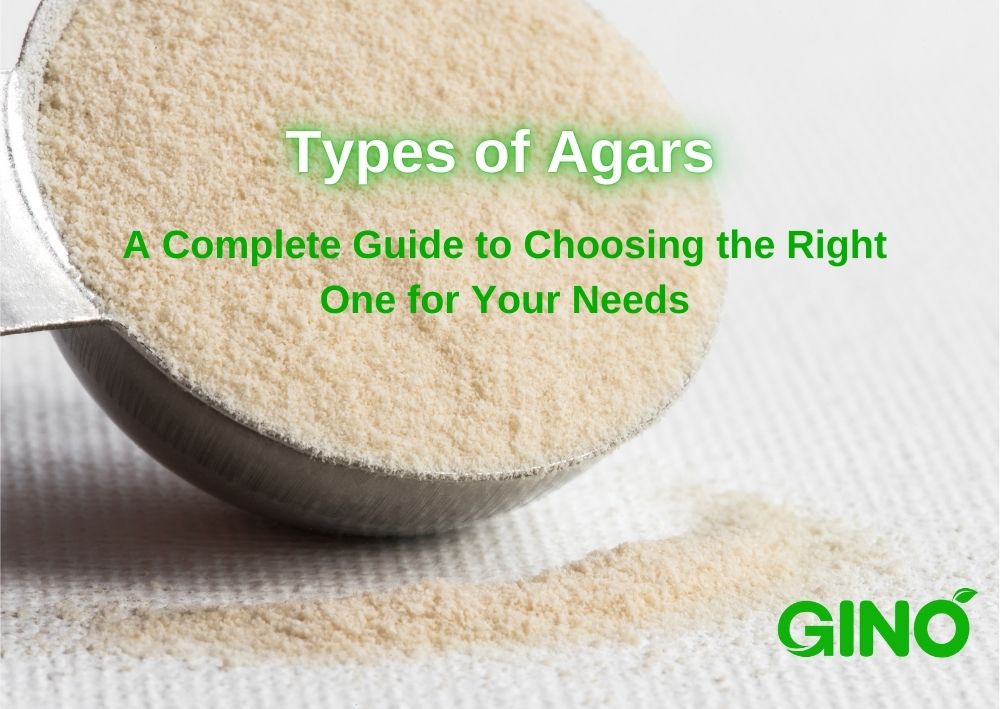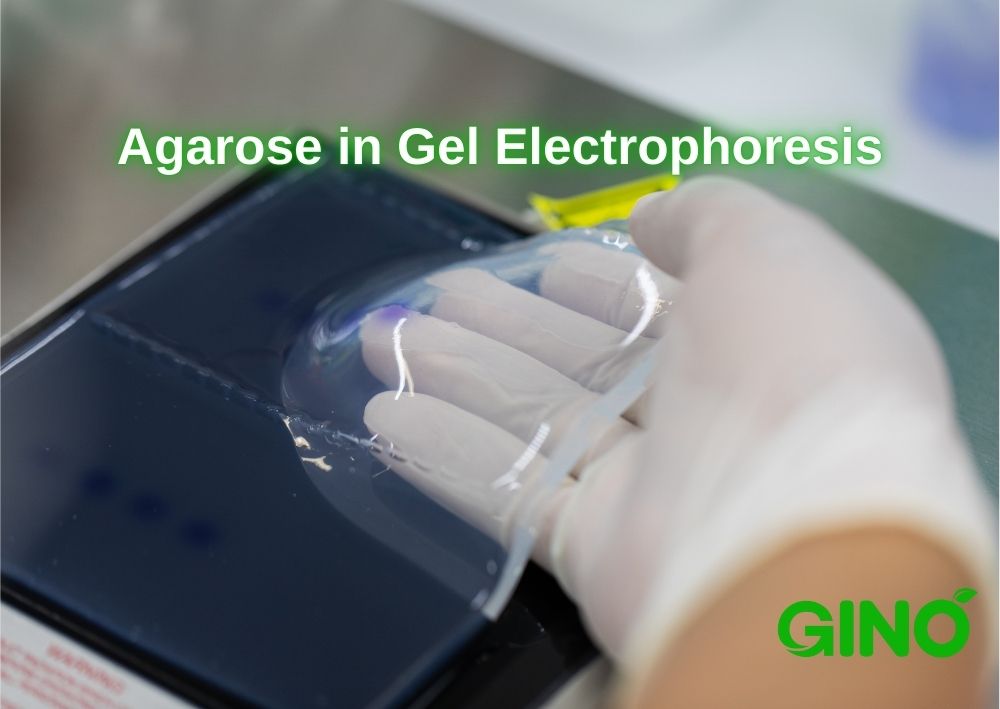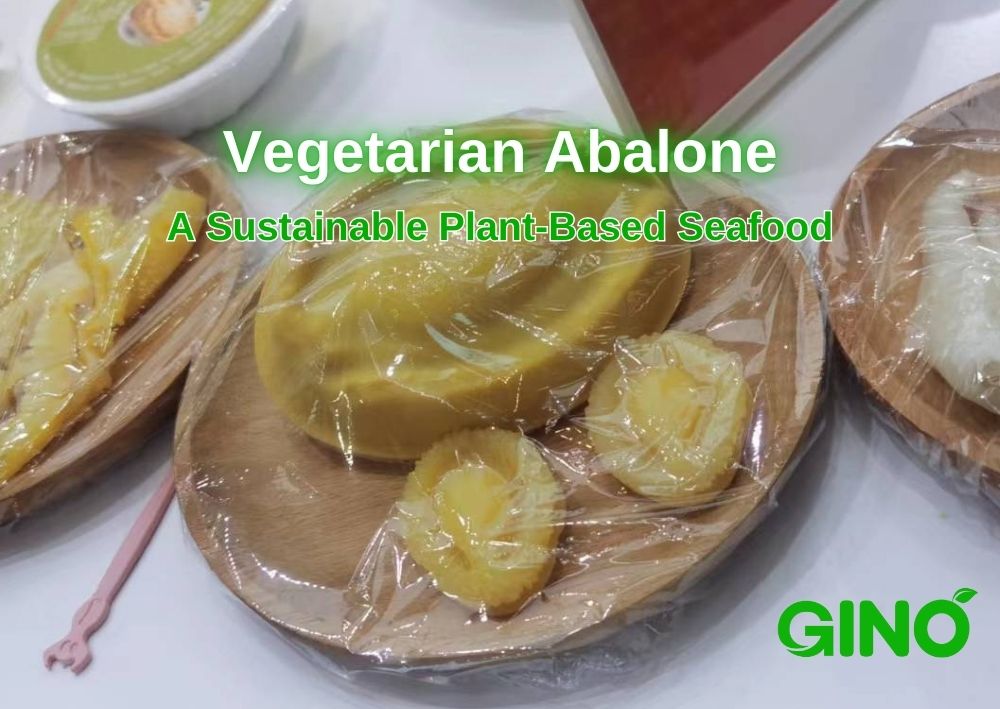لأكثر من 10 سنوات، كانت جينو بيوتك موردًا رئيسيًا للمواد الهيدروكولويدية الغذائية. من خلال مجموعة متنوعة من الصمغ والمثبتات النباتية، يمكننا إنشاء حلول هيدروكولويدية مصممة خصيصًا تتناسب تمامًا مع احتياجات عملائنا. اقرأ المزيد
الأغاروز في الرحلان الكهربائي: كل ما تحتاج إلى معرفته
الأغاروز في الرحلان الكهربائي
فيسبوك
تويتر
لينكد إن
1. مقدمة
أغاروز في الرحلان الكهربائي أداة أساسية للباحثين في البيولوجيا الجزيئية. فقدرته على فصل الأحماض النووية والبروتينات بدقة جعلته تقنية أساسية لعقود من الزمن. ولكن ما الذي يجعل الأغاروز مميزًا جدًا في الرحلان الكهربائي؟
في هذا الدليل، سنتناول في هذا الدليل خصائصه وتطبيقاته والإجابات على الأسئلة الرئيسية مثل "فيمَ يُستخدم الأغاروز في الرحلان الكهربائي الهلامي؟" و "ما هو هلام الأغاروز الكهربائي؟"

2. ما هو الأغاروز في الرحلان الكهربائي الهلامي؟
الأغاروز هو بوليمر طبيعي مستخرج من الأعشاب البحرية، وتحديداً من أنواع مثل جيليديوم و جراسيلاريا. ويشكل هلامًا عند إذابته في محلول عازل وتبريده، مما يؤدي إلى تكوين شبكة مسامية.
في الرحلان الكهربي الهلامي، يعمل الأغاروز كغربال يفصل الجزيئات مثل الحمض النووي أو الحمض النووي الريبي (DNA) أو الحمض النووي الريبي (RNA) أو البروتينات بناءً على الحجم. تتحكم المسام الموجودة في الهلام في حركة الجزيئات تحت مجال كهربائي، حيث تنتقل الجزيئات الأصغر حجمًا أسرع من الأجزاء الأكبر حجمًا.
ما هو الرحلان الكهربائي الهلامي الأغاروزي؟
الرحلان الكهربائي لهلام الأغاروز هو تقنية مختبرية تُستخدم لتحليل الأحماض النووية. من خلال تطبيق مجال كهربائي على هلام الأغاروز، تهاجر جزيئات الحمض النووي السالب الشحنة أو الحمض النووي الريبي نحو القطب الموجب. يعتمد معدل الهجرة على حجم الجزيئات مما يسمح بالفصل والتحليل الفعال.

3. الخواص الرئيسية للأغاروز للرحلان الكهربائي
النقاء والحياد
الأغاروز خامل كيميائيًا ونقي للغاية، مما يضمن عدم تفاعله مع الجزيئات التي يتم تحليلها.
حجم المسام القابل للتعديل
من خلال تعديل تركيز الأغاروز في الهلام، يمكنك التحكم في حجم المسام لتطبيقات مختلفة:
- تركيزات منخفضة (على سبيل المثال، 0.5-1.0%): مثالية لشظايا الحمض النووي الكبيرة (>1,000 نقطة أساس).
- تركيزات عالية (على سبيل المثال، 1.5-2.5%): مناسب لشظايا الحمض النووي الأصغر (<500 نقطة أساس).
قابلية الارتداد الحراري
يمكن إذابة المواد الهلامية الأغاروزية وإعادة توحيدها، وهو أمر مفيد لاستخراج أجزاء الحمض النووي للتطبيقات النهائية.
القوة والثبات
تتميز المواد الهلامية الأغاروزية بمتانتها الميكانيكية، مما يسهل التعامل معها أثناء الرحلان الكهربائي.
هل تتطلع إلى ابتكار المزيد من خيارات الجيلي النباتي الصديق للنباتيين؟
يمكن أن تساعدك مجموعتنا من مساحيق الجيلي عالية الجودة وحلول التبلور على صنع حلويات نباتية لذيذة بسهولة. اتصل بنا اليوم لمعرفة المزيد عن كيفية صنع الجيلي النباتي ووصفات الجيلي النباتي القابلة للتخصيص!
4. تطبيقات الأغاروز في الرحلان الكهربي الهلامي
يستخدم الأغاروز في الرحلان الكهربائي في مجموعة واسعة من التطبيقات في البيولوجيا الجزيئية والكيمياء الحيوية:
1. تحليل الحمض النووي والحمض النووي الريبي
- التحقق من حجم الأحماض النووية وسلامتها ونقائها بعد تفاعل البوليميراز المتسلسل أو هضم إنزيم التقييد أو الاستخلاص.
- تحليل الواسمات الوراثية أو الطفرات أو نتائج التسلسل.
2. عزل شظايا الحمض النووي (DNA)
غالبًا ما تُستخدم المواد الهلامية الأغاروزية لاستخراج أجزاء محددة من الحمض النووي للاستنساخ أو التسلسل أو غيرها من العمليات النهائية.
3. القياس الكمي ومراقبة الجودة
استخدام هلام الأغاروز لتقدير تركيز وجودة الأحماض النووية، خاصةً في مهام سير العمل التي تتطلب دقة عالية.
4. تحليل البروتين
في حين أن الأغاروز ليس شائع الاستخدام للبروتينات مثل المواد الهلامية من بولي أكريلاميد، إلا أنه مناسب للبروتينات أو المجمعات الكبيرة.
5. التقدم في تكنولوجيا هلام الأغاروز
شهد مجال الرحلان الكهربي لهلام الأغاروز تقدمًا ملحوظًا، مما أدى إلى تحسين الكفاءة والدقة للباحثين.
أغاروز منخفض الذوبان يعد ابتكارًا مهمًا، حيث يسمح باستعادة أجزاء الحمض النووي أو الحمض النووي الريبي دون تغيير طبيعة الحمض النووي. هذا النوع من الأغاروز مفيد بشكل خاص في التطبيقات النهائية مثل الاستنساخ أو التفاعلات داخل الهلام.
مواد هلامية أغاروزية مسبقة الصب متوفرة الآن على نطاق واسع، مما يوفر الوقت للمختبرات من خلال الاستغناء عن الحاجة إلى التحضير اليدوي للهلام. هذه المواد الهلامية جاهزة للاستخدام وتأتي بتركيزات أغاروز مقيسة مسبقًا ومُحسّنة للاستخدامات المختلفة.
أغاروز عالي الأداء لحل أجزاء الحمض النووي الأصغر حجمًا بنطاقات أكثر وضوحًا. وهذا التقدم مفيد في التنميط الجيني والتحليل الجنائي واكتشاف الطفرات.
توضح هذه الابتكارات كيف يتطور المجال لتلبية المتطلبات المتزايدة للبيولوجيا الجزيئية، مما يجعل التجارب أسرع وأكثر دقة وسهولة في الاستخدام.
6. اختيار تركيز الأغاروز المناسب
يؤثر تركيز الأغاروز في الهلام على أدائه:
- جل 5-1.01.0%: مناسب لفصل شظايا الحمض النووي الكبيرة (1,000 إلى 20,000 نقطة أساس).
- 0-1.51- 1.5% جل: مثالي لشظايا الحمض النووي متوسطة الحجم (500-1,000 بيكسل).
- 5-2.5% جل 5-2.5%: الأفضل لشظايا الحمض النووي الصغيرة (أقل من 500 بي بي).
يضمن اختيار التركيز الصحيح الدقة المثلى والنتائج الواضحة.
7. خيارات التغليف لأبحاثك
نوفر أجاروز عالي الجودة للرحلان الكهربائي في عبوات مرنة لتناسب مختلف الاحتياجات:
- التعبئة والتغليف بالجملة: علب كرتون 10 كجم أو براميل ألياف 25 كجم.
- عبوات التجزئة: خيارات أصغر مثل 1 كجم أو 500 جرام أو حتى كميات مخصصة.
8. الأسئلة الشائعة حول الأغاروز في الرحلان الكهربائي
ما هو الأغاروز المستخدم في الرحلان الكهربائي الهلامي؟
الأغاروز هو الوسيط الأساسي لفصل الحمض النووي والحمض النووي الريبي وأحيانًا البروتينات في الرحلان الكهربائي الهلامي. طبيعته الخاملة وحجم مسامه القابل للضبط تجعله مثاليًا لمجموعة واسعة من أحجام الأجزاء.
ما هو الرحلان الكهربائي الهلامي الأغاروزي؟
إنها تقنية لفصل وتحليل الأحماض النووية حسب الحجم. تُستخدم هذه الطريقة على نطاق واسع في مهام مثل التحقق من نواتج تفاعل البوليميراز المتسلسل، وتحضير الحمض النووي للاستنساخ، وتحليل سلامة الحمض النووي الريبي.
ما هو الأغاروز في الرحلان الكهربائي الهلامي؟
يشير الأغاروز في الرحلان الكهربائي الهلامي إلى المصفوفة الهلامية التي تتكون من الأغاروز التي تتيح فصل الجزيئات الحيوية على أساس الحجم.

9. الخاتمة: أهمية الأغاروز في الرحلان الكهربائي
يُعدّ الأغاروز في الرحلان الكهربائي أداة حيوية للبيولوجيا الجزيئية، حيث يتيح الفصل والتحليل الدقيق للأحماض النووية. سواء كنت تستكشف "فيمَ يُستخدم الأغاروز في الرحلان الكهربائي الهلامي؟" أو تحليل عينات الحمض النووي (DNA)، يوفر الأغاروز موثوقية وسهولة استخدام لا مثيل لها.
هل تبحث عن أجاروز عالي الجودة لتلبية احتياجاتك من الرحلان الكهربائي؟
اتصل بنا اليوم لمعرفة المزيد عن منتجاتنا والعثور على الحل الأمثل لأبحاثك. بفضل خيارات التغليف القابلة للتخصيص ودعم الخبراء، نحن هنا للارتقاء بنتائج مختبرك.
تواصل مع فريقناأحدث المنشورات
كيفية صنع الجيلي النباتي: وصفة مبهجة للجميع
2025-01-05
نبذة عن جينو للتكنولوجيا الحيوية

نحن شركة تكنولوجيا حيوية متخصصة في البحث والتطوير والتسويق التجاري للإضافات الغذائية المبتكرة والتكنولوجية للمواد الهيدروكولويدية المائية أجار أجار, كراجينان, و حلول مثبتات مصممة خصيصاً حسب الطلب.
بفضل المعرفة والخبرة الممتدة في مجال البحث عن المواد الهيدروكولويدية وتطبيقها واستخدامها، يمكننا توفير حلول مخصصة تتوافق تمامًا مع احتياجات عملائنا.
لدينا المنتجات تغطية احتياجات اللحوم والألبان والمخابز والحلويات والقطاعات الصناعية الأخرى.














